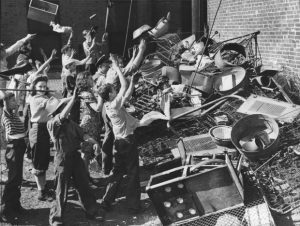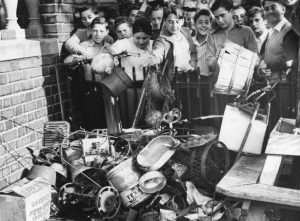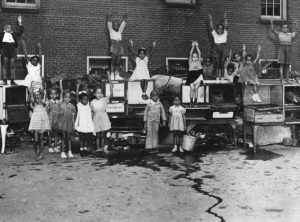 When the United States was pulled into World War II following the Japanese attack on Pearl Harbor. raw materials were in high demand globally, and hard to come by. Commodities such as rubber and cloth became precious and very valuable to the war effort. Many of the men were now off fighting the war, and so the factories, mines, etc. were not producing the necessary materials to build the much needed military equipment and weapons for the war effort.
When the United States was pulled into World War II following the Japanese attack on Pearl Harbor. raw materials were in high demand globally, and hard to come by. Commodities such as rubber and cloth became precious and very valuable to the war effort. Many of the men were now off fighting the war, and so the factories, mines, etc. were not producing the necessary materials to build the much needed military equipment and weapons for the war effort.
When it was decided that the country needed a drive to supply these materials, the Community-Minded Patriotism of the United States Home Front swung into action. The nation decided that they needed a drive to collect the materials needed. On Oct. 5, 1942, the first day of the first drive, young people throughout the city and county hauled in 2,800 tons of scrap metal to feed industry during World War II. By Oct. 16, the end of the campaign, their total was 7,658 tons, which is the combined weight of 230 Sherman tanks.
More scrap drives were organized across the country, encouraging citizens to contribute their rubber to make jeep tires, their clothing to make cleaning rags, their nylon and silk stockings to make parachutes, and their leftover cooking fat to make explosives. One of the most vital materials to collect was scrap metal. A single medium tank required 18 tons of it, and a single Navy ship hundreds more. For many people, I’m sure it looked like a great way to get rid of all those items most of us would try to unload at a garage sale.
The scrap metal drives became very competitive, almost frenzied affairs, as communities fought to out-contribute each other. Housewives threw in their aluminum pots and pans, farmers sacrificed their old tractors, and cities and towns ripped up wrought iron fences, trolley tracks and historic Civil War cannons. People were encouraged to imagine their household items being transformed into armor and weaponry for their soldiers and  sailors in harm’s way. It was a great way to energize the Home Front. In Lubbock, Texas, a bust of Hitler was erected as a target for patriotic citizens to hurl their cookware. It was a way to take out their anger a little bit, and it worked. Walt Disney donated two iron Bambi sculptures, which were said to contain enough iron for 10,000 incendiary bombs or one 75 millimeter artillery piece. In all reality, the effect of these scrap metal drives on actual war production was very small, marginal at best. Nevertheless, their true value was in galvanizing citizen morale and a sense of patriotic unity…making everyone like they took part in the war effort. So, in the end, the scrap days did their job very well.
sailors in harm’s way. It was a great way to energize the Home Front. In Lubbock, Texas, a bust of Hitler was erected as a target for patriotic citizens to hurl their cookware. It was a way to take out their anger a little bit, and it worked. Walt Disney donated two iron Bambi sculptures, which were said to contain enough iron for 10,000 incendiary bombs or one 75 millimeter artillery piece. In all reality, the effect of these scrap metal drives on actual war production was very small, marginal at best. Nevertheless, their true value was in galvanizing citizen morale and a sense of patriotic unity…making everyone like they took part in the war effort. So, in the end, the scrap days did their job very well.


Leave a Reply